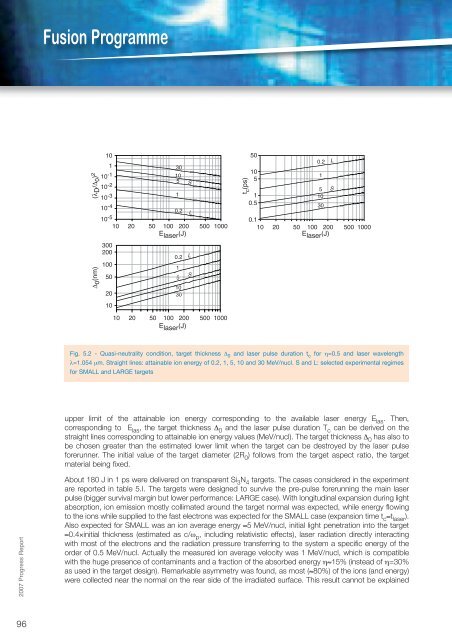Fusion Programme - ENEA - Fusione
Fusion Programme - ENEA - Fusione
Fusion Programme - ENEA - Fusione
- No tags were found...
Create successful ePaper yourself
Turn your PDF publications into a flip-book with our unique Google optimized e-Paper software.
<strong>Fusion</strong> <strong>Programme</strong>(λ D /Δ 0 ) 2Δ 0 (nm)10110 -110 -210 -310510 -40.2 L10 -5 10 20 50 100 200 500 1000E laser (J)300200100502010301S0.2 L1S51030t c (ps)5010510.50.20.110 20 50 100 200 500 1000E laser (J)151030LS10 20 50 100 200 500 1000E laser (J)Fig. 5.2 - Quasi-neutrality condition, target thickness Δ 0 and laser pulse duration t c for η=0.5 and laser wavelengthλ=1.054 μm. Straight lines: attainable ion energy of 0.2, 1, 5, 10 and 30 MeV/nucl. S and L: selected experimental regimesfor SMALL and LARGE targetsupper limit of the attainable ion energy corresponding to the available laser energy E las . Then,corresponding to E las , the target thickness Δ 0 and the laser pulse duration T c can be derived on thestraight lines corresponding to attainable ion energy values (MeV/nucl). The target thickness Δ 0 has also tobe chosen greater than the estimated lower limit when the target can be destroyed by the laser pulseforerunner. The initial value of the target diameter (2R 0 ) follows from the target aspect ratio, the targetmaterial being fixed.2007 Progress ReportAbout 180 J in 1 ps were delivered on transparent Si 3 N 4 targets. The cases considered in the experimentare reported in table 5.I. The targets were designed to survive the pre-pulse forerunning the main laserpulse (bigger survival margin but lower performance: LARGE case). With longitudinal expansion during lightabsorption, ion emission mostly collimated around the target normal was expected, while energy flowingto the ions while supplied to the fast electrons was expected for the SMALL case (expansion time t c ≈t laser ).Also expected for SMALL was an ion average energy ≈5 MeV/nucl, initial light penetration into the target≈0.4×initial thickness (estimated as c/ω p , including relativistic effects), laser radiation directly interactingwith most of the electrons and the radiation pressure transferring to the system a specific energy of theorder of 0.5 MeV/nucl. Actually the measured ion average velocity was 1 MeV/nucl, which is compatiblewith the huge presence of contaminants and a fraction of the absorbed energy η≈15% (instead of η=30%as used in the target design). Remarkable asymmetry was found, as most (≈80%) of the ions (and energy)were collected near the normal on the rear side of the irradiated surface. This result cannot be explained96













